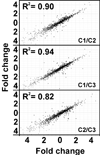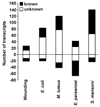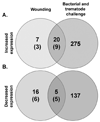Differential transcriptomic responses of Biomphalaria glabrata (Gastropoda, Mollusca) to bacteria and metazoan parasites, Schistosoma mansoni and Echinostoma paraensei (Digenea, Platyhelminthes)
- PMID: 19962194
- PMCID: PMC2814977
- DOI: 10.1016/j.molimm.2009.10.019
Differential transcriptomic responses of Biomphalaria glabrata (Gastropoda, Mollusca) to bacteria and metazoan parasites, Schistosoma mansoni and Echinostoma paraensei (Digenea, Platyhelminthes)
Abstract
A 70-mer-oligonucleotide-based microarray (1152 features) that emphasizes stress and immune responses factors was constructed to study transcriptomic responses of the snail Biomphalaria glabrata to different immune challenges. In addition to sequences with relevant putative ID and Gene Ontology (GO) annotation, the array features non-immune factors and unknown B. glabrata ESTs for functional gene discovery. The transcription profiles of B. glabrata (3 biological replicates, each a pool of 5 snails) were recorded at 12h post-wounding, exposure to Gram negative or Gram positive bacteria (Escherichia coli and Micrococcus luteus, respectively), or infection with compatible trematode parasites (Schistosoma mansoni or Echinostoma paraensei, 20 miracidia/snail), relative to controls, using universal reference RNA. The data were subjected to Significance Analysis for Microarrays (SAM), with a false positive rate (FPR) <or=10%. Wounding yielded a modest differential expression profile (27 up/21 down) with affected features mostly dissimilar from other treatments. Partially overlapping, yet distinct expression profiles were recorded from snails challenged with E. coli (83 up/20 down) or M. luteus (120 up/42 down), mostly showing up-regulation of defense and stress-related features. Significantly altered expression of selected immune features indicates that B. glabrata detects and responds differently to compatible trematodes. Echinostoma paraensei infection was associated mostly with down-regulation of many (immune-) transcripts (42 up/68 down), whereas S. mansoni exposure yielded a preponderance of up-regulated features (140 up/23 down), with only few known immune genes affected. These observations may reflect the divergent strategies developed by trematodes during their evolution as specialized pathogens of snails to negate host defense responses. Clearly, the immune defenses of B. glabrata distinguish and respond differently to various immune challenges.
Copyright 2010 Elsevier Ltd. All rights reserved.
Figures






Similar articles
-
Time series analysis of the transcriptional responses of Biomphalaria glabrata throughout the course of intramolluscan development of Schistosoma mansoni and Echinostoma paraensei.Int J Parasitol. 2010 Jun;40(7):819-31. doi: 10.1016/j.ijpara.2009.12.005. Epub 2010 Jan 18. Int J Parasitol. 2010. PMID: 20083115 Free PMC article.
-
Different metazoan parasites, different transcriptomic responses, with new insights on parasitic castration by digenetic trematodes in the schistosome vector snail Biomphalaria glabrata.BMC Genomics. 2024 Jun 17;25(1):608. doi: 10.1186/s12864-024-10454-4. BMC Genomics. 2024. PMID: 38886647 Free PMC article.
-
Comparative ORESTES-sampling of transcriptomes of immune-challenged Biomphalaria glabrata snails.J Invertebr Pathol. 2008 Oct;99(2):192-203. doi: 10.1016/j.jip.2008.06.002. Epub 2008 Jun 12. J Invertebr Pathol. 2008. PMID: 18590737 Free PMC article.
-
Epigenetic modulation, stress and plasticity in susceptibility of the snail host, Biomphalaria glabrata, to Schistosoma mansoni infection.Int J Parasitol. 2016 Jun;46(7):389-94. doi: 10.1016/j.ijpara.2016.03.003. Epub 2016 Apr 4. Int J Parasitol. 2016. PMID: 27056272 Review.
-
Advances in gastropod immunity from the study of the interaction between the snail Biomphalaria glabrata and its parasites: A review of research progress over the last decade.Fish Shellfish Immunol. 2015 Sep;46(1):5-16. doi: 10.1016/j.fsi.2015.01.036. Epub 2015 Feb 7. Fish Shellfish Immunol. 2015. PMID: 25662712 Review.
Cited by
-
Will all scientists working on snails and the diseases they transmit please stand up?PLoS Negl Trop Dis. 2012;6(12):e1835. doi: 10.1371/journal.pntd.0001835. Epub 2012 Dec 27. PLoS Negl Trop Dis. 2012. PMID: 23301104 Free PMC article. No abstract available.
-
Polyethyleneimine (PEI) mediated siRNA gene silencing in the Schistosoma mansoni snail host, Biomphalaria glabrata.PLoS Negl Trop Dis. 2011 Jul;5(7):e1212. doi: 10.1371/journal.pntd.0001212. Epub 2011 Jul 12. PLoS Negl Trop Dis. 2011. PMID: 21765961 Free PMC article.
-
Investigation of defense response and immune priming in Biomphalaria glabrata and Biomphalaria straminea, two species with different susceptibility to Schistosoma mansoni.Parasitol Res. 2020 Jan;119(1):189-201. doi: 10.1007/s00436-019-06495-4. Epub 2019 Dec 10. Parasitol Res. 2020. PMID: 31820168
-
High throughput sequencing of small RNAs transcriptomes in two Crassostrea oysters identifies microRNAs involved in osmotic stress response.Sci Rep. 2016 Mar 4;6:22687. doi: 10.1038/srep22687. Sci Rep. 2016. PMID: 26940974 Free PMC article.
-
Early differential gene expression in haemocytes from resistant and susceptible Biomphalaria glabrata strains in response to Schistosoma mansoni.PLoS One. 2012;7(12):e51102. doi: 10.1371/journal.pone.0051102. Epub 2012 Dec 26. PLoS One. 2012. PMID: 23300533 Free PMC article.
References
-
- Abraham EG, Islam S, Srinivasan P, Ghosh AK, Valenzuela JG, Ribeiro JM, Kafatos FC, Dimopoulos G, Jacobs-Lorena M. Analysis of the Plasmodium and Anopheles transcriptional repertoire during ookinete development and midgut invasion. J Biol Chem. 2004;279:5573–5580. - PubMed
-
- Archambault V, Glover DM. Polo-like kinases: conservation and divergence in their functions and regulation. Nat Rev Mol Cell Biol. 2009;10:265–275. - PubMed
-
- Azumi K, De Santis R, De Tomaso A, Rigoutsos I, Yoshizaki F, Pinto MR, Marino R, Shida K, Ikeda M, Arai M, Inoue Y, Shimizu T, Satoh N, Rokhsar DS, Du Pasquier L, Kasahara M, Satake M, Nonaka M. Genomic analysis of immunity in a Urochordate and the emergence of the vertebrate immune system: "waiting for Godot". Immunogenetics. 2003;55:570–581. - PubMed
Publication types
MeSH terms
Substances
Grants and funding
LinkOut - more resources
Full Text Sources
Molecular Biology Databases
Research Materials
Miscellaneous

